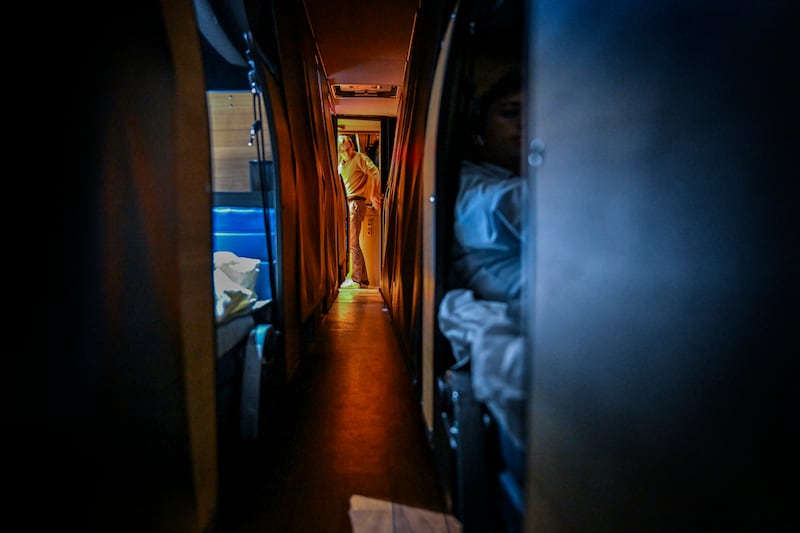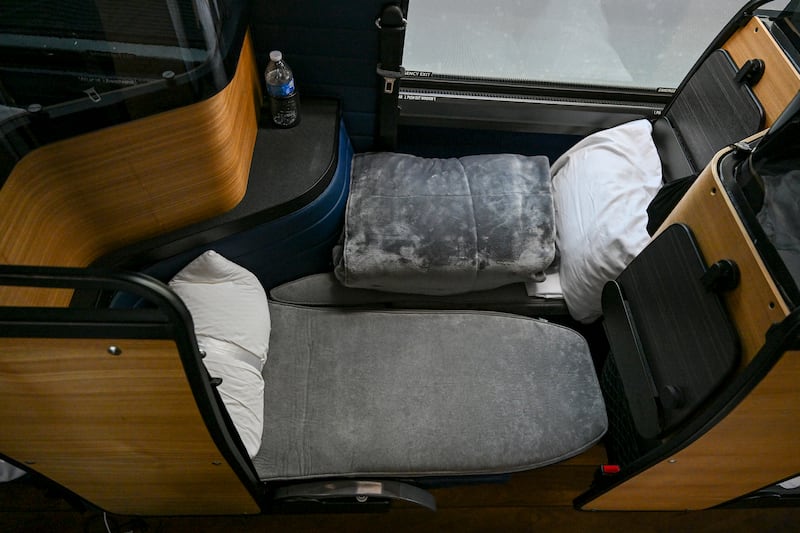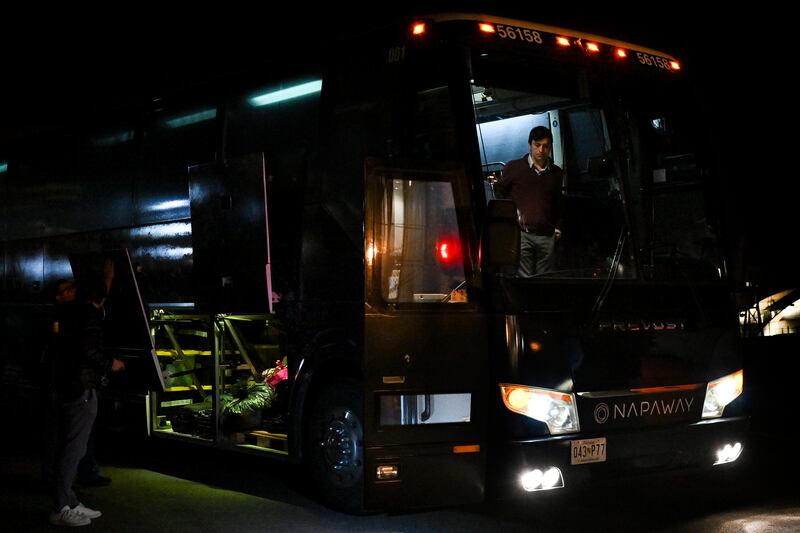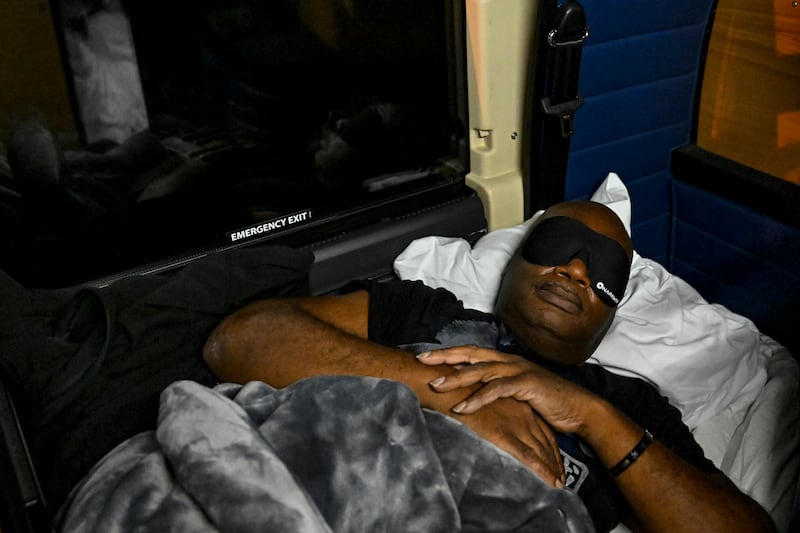John Rosenberg found a last-minute flight for about €199 ($200) last month from Washington, DC, to Nashville, Tennessee, to see Pearl Jam. But flights home were about €599 ($600), and there was no easy way to take the train.
The American started searching for buses online. He stumbled on Napaway, a company that promises premium overnight accommodation on an 18-passenger bus with seats that fold into a flat bed and come with a pillow and plush blanket.
The week before, Rosenberg and his friends had spent 18 hours at Midway Airport, in Chicago, after they were bounced off their connecting flight to Washington. He spent the night cold and slept a total of 45 minutes in the airport chapel before security kicked him out.
The Napaway, Rosenberg reasoned, could not be worse. And at least he would be travelling, not waiting. He booked the flight to Nashville and a ticket home on the Napaway for $125. “My friends were all making fun of me,” the 47-year-old said. “You’re going to spend 11 hours on a luxury bus?” He was.
A New Zealander in Dublin: ‘It feels like people work to live here as opposed to living to work’
Family fallouts: ‘I can’t describe the heartache of not having a relationship with my sister’
Zach Bryan in Dublin review: Gen Z’s Garth Brooks puts on a charming – and lengthy – show
How the death of an ‘old boy from Ireland’ in London-Irish suburb sparked a misguided viral appeal
On a Sunday night, after spending the weekend in Nashville, Rosenberg joined five other passengers, including me, on the Napaway, which in June began taking travellers back and forth from Washington to Nashville, about 1,000km away.
The company and other premium bus companies like it are betting that Americans will abandon the image of the rumbling, cramped bus as the transport of last resort for the cash-strapped and embrace long-haul coach travel.

Giant sleeper buses have been a staple of travel in parts of Latin America and Asia for decades. But in the US the concept has never taken hold, despite its vast highway system. Around 2017, Cabin, a two-storey bus with beds tucked into private pods, began taking passengers the 600km from Los Angeles to San Francisco for overnight trips but stopped in 2020.
More successful have been high-end coach services that offer shorter journeys, including the Jet, a 14-seat bus that ferries people from Metro Center in Washington to Hudson Yards, 375km away, in the New York City borough of Manhattan. They advertise seats that recline far back, high-speed wifi and a feeling that, even though you’re technically on an intercity bus, you are on a refined, affordably priced journey, says Andisheh Ranjbari, an assistant professor of travel behaviour at Penn State University.
“You don’t see the word bus anywhere in the advertisements,” she says. “They say it’s a first-class luxury experience.”
Napaway is the only “fully flat” sleeper bus in the US, says its founder and chief executive, Dan Aronov. He is aware that many travellers may be sceptical of taking a 10- to 11-hour bus ride when a flight from Washington to Nashville takes less than two hours.
He responds by pointing out how miserable the airport experience can be. Flying is faster, but a passenger will still spend several hours getting to the airport, going through security and then waiting at the gate. And that is assuming a flight is not delayed, says the 29-year-old.
Contrast that experience with travelling while lying on a memory foam mattress pad and snuggling under a blanket, he says. “You were going to spend seven to eight hours asleep. Now you’re just doing it in motion.”


Premium coach lines have significantly fewer overhead costs than rail and, especially, airlines, which have much higher fuel costs and need a “small army” of employees to operate, says Joseph Schwieterman, professor of public service at DePaul University in Chicago and director of the Chaddick Institute for Metropolitan Development, which studies intercity bus travel.
By contrast, a premium bus requires a crew of one or two drivers and perhaps one attendant, which means that even if a company sells fewer than half of its seats on a trip it can still cover its costs, so long as it does not lower fares to compete with conventional bus lines.
‘I would go anywhere on this bus’
— Ammie Conner
Mia Reed, a singer from the New York City borough of Brooklyn who finds trains too costly and flights inconvenient, says she was eager to find a luxury bus that would take her to visit her parents in Fredericksburg, Virginia, about 450km away, after having “nightmare” experiences on other buses.
The 29-year-old says she learned about the Jet on Instagram and TikTok, where videos show wide seats powered by “motion-cancelling technology”. Booking online is easy, and the Jet is “beautiful” and “a little bit better organised” than an ordinary bus, Reed says, adding that an attendant came by frequently during the four-hour trip to check on passengers and pass out snacks, coffee, wine and soft drinks.
“It’s meant to feel like a private-jet experience,” says the company’s founder and chief executive, Chad Scarborough. “Hence the name the Jet.”
[ Do the planet a favour and take the train instead of the planeOpens in new window ]
I arrive in Washington on Friday to catch the Napaway with my friend Theresa. We find the bus at 9.30pm at the designated meeting spot — a well-lit parking lot near the Wunder Garten, an outdoor beer garden where Miley Cyrus’s Party in the USA blares from the speakers and the sound of laughter wafts over the fence.
We are joined by three other passengers: Ammie Conner, an 80-year-old retiree who is visiting her grandson in Nashville; Guillerma Saltano, a shy, 50-year-old woman from the Dominican Republic; and Catherine Lee, a 50-year-old graduate student studying social work.


We gawk at the bus, an enormous black coach with a galaxy of stars painted on the side. Inside are 36 seats — two for each passenger — that convert into flat, sort of S-shaped beds.
Conner, who skydived for the first time at age 70 and went zip-lining at 80, says she booked the bus “for the novelty of it”. She says when she told a friend about the bus, the friend replied, “‘What a great idea for a bachelorette party’.” But rowdy partygoers run counter to the ethos of the Napaway, which asks passengers to refrain from loud talking or playing their devices out loud.
No one younger than eight can ride the Napaway, says Aronov. The Jet, which charges fares starting at $99 for a one-way ticket, has a minimum age of six. “I’m very sympathetic to parents,” Aronov says. “But right now, for the comfort of the other passengers, we have an age minimum.”
‘This was fantastic...most comfortable I’ve ever been on a bus’
— John Rosenberg
Aronov says he chose Nashville because it’s a busy urban hub popular with tourists in an area of the US with few public-transit options. An Oxford University graduate who worked at Barclays Investment Bank and Loews Corp, Aronov says he started Napaway with the help of individual investors, not large institutions. He declines to say how much it cost to start Napaway but says the company is not breaking even yet. “It’s a new concept, and it takes time for the word to get out.”
Aronov joins us on my trip — he says he tries to ride the Napaway as much as possible. As the bus pulls away he describes how to lower the seats and pull down the black privacy screen. Each passenger receives a sleep mask, toothpaste and a small toothbrush, ear plugs and a disposable towelette.
[ Sleeping around Europe: The revival of night trainsOpens in new window ]
Saltano struggles with her privacy screen, and Aronov rushes to help her. She burrows under her blanket, looks at her phone for a few minutes, then quickly falls asleep.
I lower my seats, lay the mattress down, curl into the foetal position and drift off to sleep, wondering if someone over 6ft tall would be as comfortable. (Aronov says the beds are long enough that anyone up to 6ft 4in should be able to lie flat without having to curl up their knees.)


I wake briefly at 2am. If anyone is snoring I cannot hear it over the soft whirring of the engine and the rumbling wheels. The bus jostles, but the rocking motion is lulling. As I drift back to sleep I imagine this was how a baby nestled in a carriage feels.
I awake at 7am, surprised by how refreshed I feel.
The bus drops us off in downtown Nashville, where my friend and I spend about 36 hours — plenty of time to visit the Country Music Hall of Fame and Museum and RCA Studio B, catch live music at Rudy’s Jazz Room, and overeat at Biscuit Love, Peg Leg Porker and Monell’s.
I meet Rosenberg, the Pearl Jam fan, on the ride back to Washington, where we are joined by Conner, Lee and Aronov. The trip home is as peaceful as the trip down. An crash on Interstate 81 creates an 8km tailback around 5am, delaying our arrival by about an hour.
No one seems annoyed. “I would go anywhere on this bus,” Conner says as she stretches and rises from her seat.
Rosenberg says he slept well — about four hours, a typical night’s sleep for him. “This was fantastic,” he tells Aronov as he steps off the bus and shakes his hand. “Most comfortable I’ve ever been on a bus.”
I ask Rosenberg if he would ride the Napaway again. Yes, he says, but only if a one-way plane ticket cost more than $300. — This article originally appeared in The New York Times
2022 The New York Times Company











